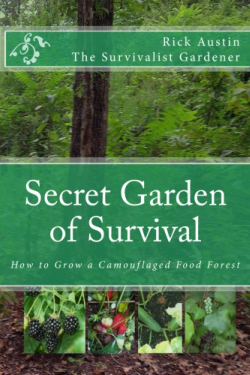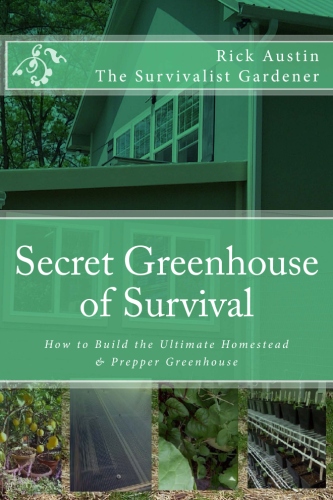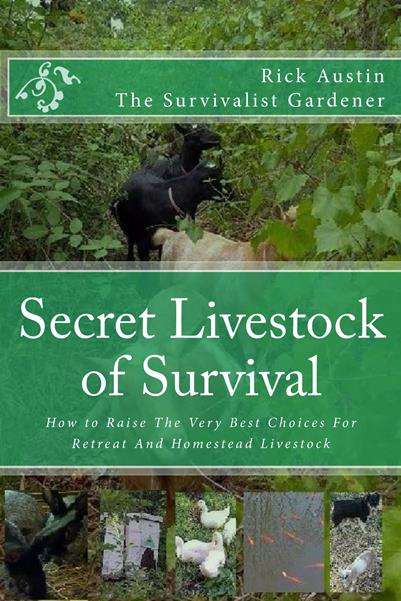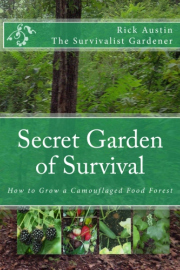#1 Best Seller! As Seen On

And see the video clips below!
Main Menu
- Home
- It’s Like the Garden of Eden
- Secret Garden – Chapter One
- Secret Greenhouse of Survival
- Secret Livestock of Survival
- Secret Garden on TV and Film
- Secret Garden Radio Interviews
- Secret Garden Reader Reviews
- Ask the Survivalist Gardener
- You Tube – Secret Garden, Greenhouse and Livestock Tips and Tricks
- How to Get the Books
- Contact
Sign up for Secret Garden News!
Join Us On Social Media
Secret Garden of Survival Book!
Secret Greenhouse of Survival!
Secret Livestock of Survival!
Sponsors
Secret Garden of Survival- Chapter One
What do I know about this?
(This is an excerpt from the Secret Garden of Survival book- Chapter 1)
I used to be a traditional apple farmer. And just like every other traditional apple farmer, I had acres of apple trees planted in rows and rows, with nothing but grass growing in between.
And just like every other traditional apple farmer, I spent a fortune on fertilizer and pesticide – every 10 days and also after every rain. Yet I still had wormy, scabby apples, just like every other farmer around me.
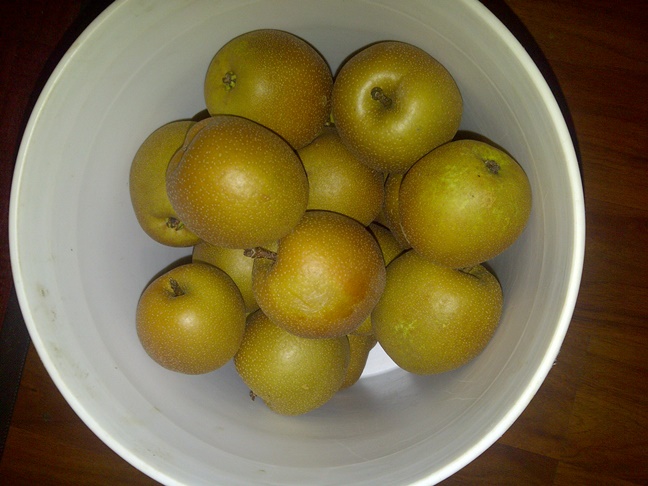
Asian Pears – grown in a food forest, without pesticide or fertilizer
Little did I know then that the grass in between the trees sucked up the same nutrients that the apple trees needed. And little did I know then that the pesticide I was using was actually making my apples a bigger target for the pests I was trying to get rid of. That is because the predator bugs that would have taken care of the pests, were dying from the pesticide faster than the pests!
Aside from having been a farmer, I have also been a “survivalist” and a “prepper” — long before they coined the terms.
Living for years in New Hampshire as I did, I learned how to prepare for and survive hard winters, where on any given day, a blizzard or ice storm could leave you without power for a week at a time. When that happens, you learn the importance of knowing how to heat and cook with wood, the importance of keeping plenty of storage food on hand, and the fundamentals of surviving the elements without power.
On the flip side, I also lived for years in Florida in the hurricane, tropical storm and lightning capital of the world. There, when the power is out, instead of freezing temperatures, you find yourself coping with 90+ degree heat and 90% humidity. And without power, computers, TV, refrigeration and air conditioning, life can be tough.
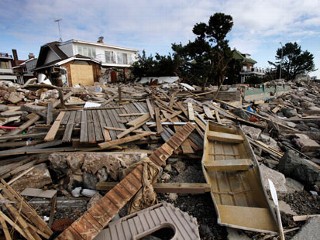
Aftermath of Hurricane Sandy (AP Photo)
Living through the aftermath of storms, with home damage, down trees, blocked roads, closed stores, empty gas stations, and the inability to use credit or debit cards at stores, makes you realize that you have to be prepared, and that you have to be self-reliant- because no one is coming to save little old you, when everyone is in the same boat.
Consequently, you learn to prepare by having adequate food storage, alternate means of cooking, cleaning, backup power, home protection, and ways to “light up the night”.
So – are you prepared for the next disaster? – Just what kind of disasters are you prepared for?
Well, the truth is that it really doesn’t matter if it is a hurricane, a flood, an earthquake, a blizzard, or an economic collapse – the results will ultimately be the same. There will be no electricity, no water, no food, no infrastructure, no grocery stores, no gas stations, and after a short time, social anarchy will ensue, with every man for himself and the zombie hordes attacking anyone that has anything they might want, in order to feed themselves and their own family.
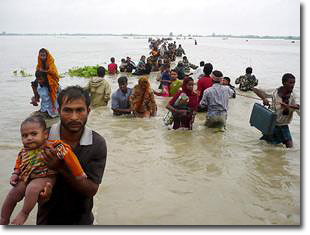
Zombie hordes approaching by sea. (AP Photo)
So how are you prepared? Do you have a bug out bag? Do you have a place to shelter? Do you have preparations for your home and your family’s defense?
How much food do you have in storage? A few days? A few weeks?
A few months? A year or more?
If there are no grocery stores, no infrastructure, and no government to help you, how are you going to feed yourself and your family in times of catastrophe – whether that is short term or long term?
Less than 100 years ago, the average family always had a year’s worth of food saved in storage to last them until the next harvest.
Aside from food storage, have you considered keeping homestead food producing animals? Chickens, ducks, goats, rabbits can all provide that small animal protein that we talked about in the Forward of this book.
Additionally these type of animals yield a high amount of protein verses their input. In other words, these small animals give you more output per pound of feed, in less space, than other sources of protein, like cattle an dairy cows do.
These small animals also provide valuable nitrogen rich nutrients in the form of manure, that will help your plants grow, giving you more feed for yourself, and for your animals.

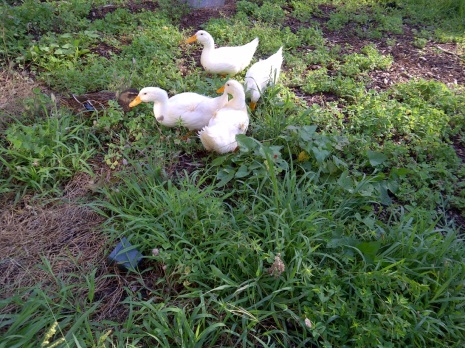
Small homestead animals are a valuable source of protien
As an aside, I prefer ducks over chickens, in that ducks produce more eggs, are generally healthier than chickens, and they travel the garden eating bugs and slugs, without digging up your tender plants (like chickens do when scratching).

People all over the world use dairy goats for milk, cheese, yogurt and other protein rich products.
OK – So let’s say you survive TEOTWAWKI (“The End Of The World As We Know It”) …and let’s say that you even survive for a whole year…
What are you and your livestock going to eat when your food stores run out?
How will you replenish a year’s supply of food storage, and then continue to feed yourself and your animals each and every year after that?
And how will you keep other people, who didn’t bother to prepare, from stealing your family’s food, when those unprepared people become a hungry, angry mob?
Imagine a food garden that you only have to plant once in your life-time, that takes up very little space, that will provide food for you and your family for the next 30 years; that can grow five times more food per square foot than traditional or commercial gardening; where you never have to weed, never have to use fertilizers and never have to use pesticide — ever.
And the whole garden is disguised to look like overgrown underbrush, so that anyone passing by would not even dream that you had food growing there!
What it is…
-In this type of gardening you let nature do what nature does best…the way nature intended it. – And as you will see later in this book, when man thinks he can do something better than nature does it, he usually screws it up.
-In many ways this type of garden uses the concept of“Permaculture” (or “permanent agriculture”). In this type of garden, you, as the gardener, only have to plant once – and a then you harvest for a lifetime.
-In this type of garden you plant in “guilds” instead of rows. Guilds are like concentric circles of plants planted around the central plant of the guild, such as a fruit or a nut tree. Your shrubs are then planted around your tree, and your herbs are planted around your shrubs and ground cover is planted around that. (We will get into more detail in Chapter 5.)
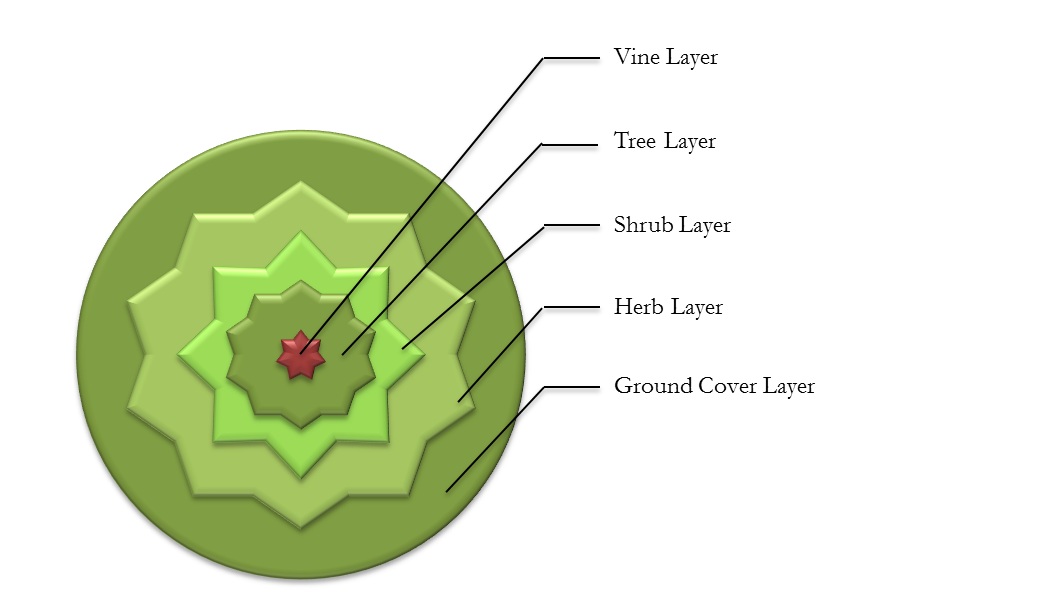
Layers of a Guild- (Top Down View)
-This type of garden also uses “companion planting”, where you put plants together that have a symbiotic relationship – a relationship where each plant supports and benefits from the other. (If you have ever heard of the book Carrots Love Tomatoes, it’s like that, only bigger.)
-This type of garden uses plants to naturally attract “good bugs” that will pollinate your plants and that will also prey on and kill the “bad bugs” that you don’t want in your garden.
-This type of garden uses plants to keep away four legged pests too. For example, if you plant onions around the base of a fruit tree, mice won’t go near the tree in the winter and gird it. (“Gird” is where an animal chews off the bark around the bottom of the tree, thus killing the tree.) Likewise, if you plant daffodils around the drip line of a tree, deer won’t go near it.
-This type of garden grows plants in three dimensions – so you can put more plants in the same area, which will significantly increases the amount of food you produce per square foot of garden space. (In fact, you can grow 5X more food per square foot in this type of garden, than you could in a traditional row garden.)
-Not only can you grow more plants in less space, but the individual plants grow better this way too! For example: In nature, vines grow on trees (not on trellises). Amazingly, the grape vines that we planted next to, and have growing on, our fruit trees, have always produced far more grapes than those vines that we planted on traditional vineyard trellises.
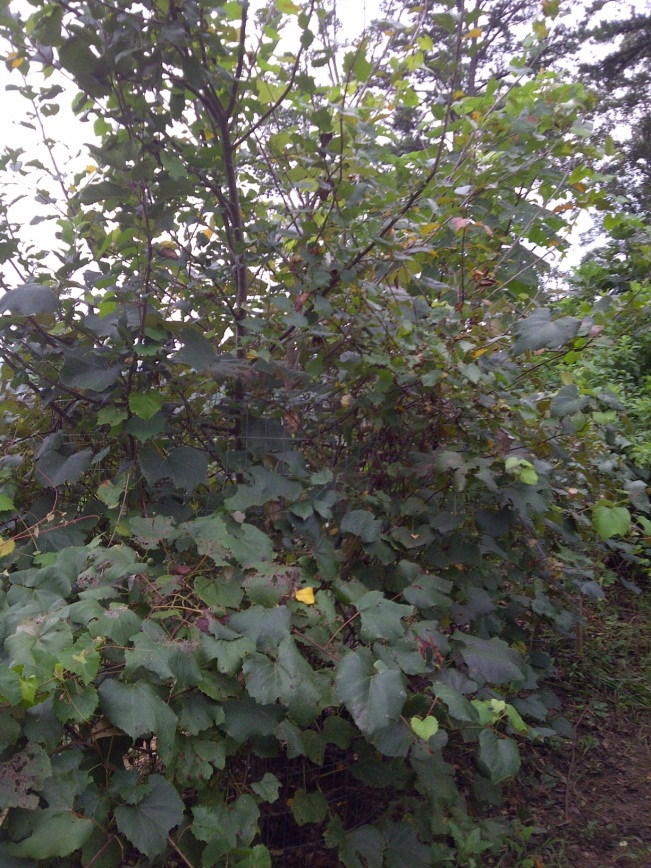
2 year old grapes growing on an apple tree
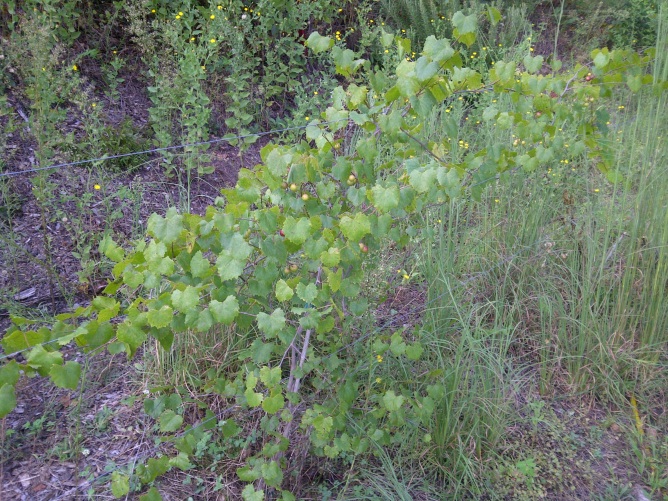
2 year old grapes growing on a trellis
-This type of garden looks wild and over grown – and just like the art of camouflage – it all blends in. Because it has no definable shapes or rows. It looks “natural”, not man-made.
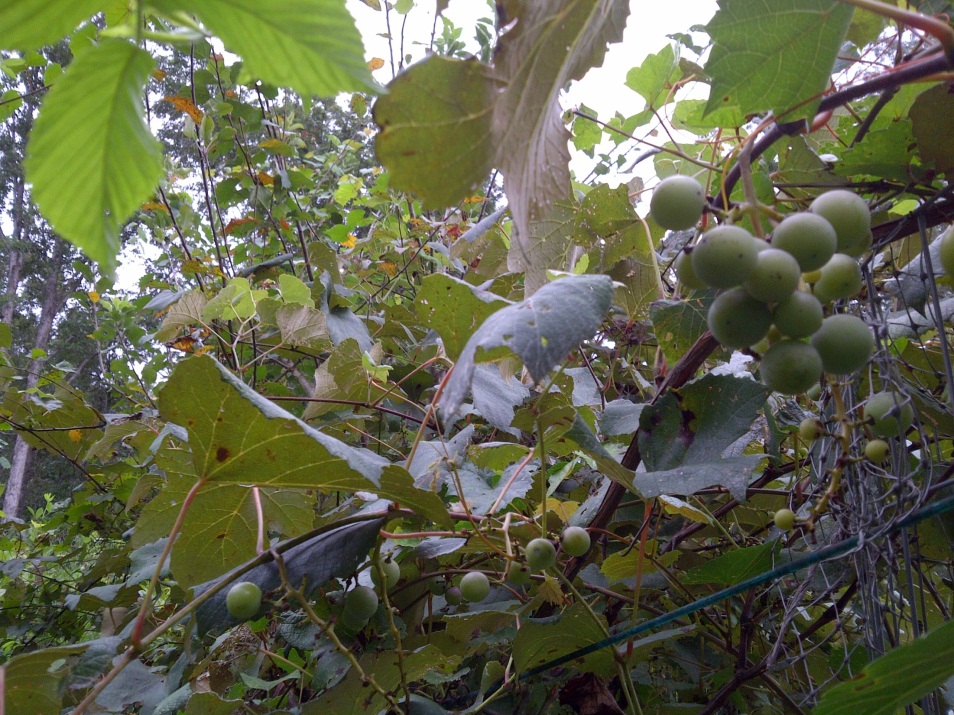
What it is not…
-It’s not work – because once you are finished with your initial planting, all you do is harvest, year after year.
-It’s not weeding – In this garden; you don’t have to pull weeds. …Because for the most part, weeds are good. You see, weeds are just misunderstood plants. Weeds are “pioneer” plants, because they are generally the first plants to inhabit a new area. As such, they serve a purpose. Weeds will grow where other plants could not survive, and in the meantime, their roots break up hard packed soil so that water, microorganisms and other nutrients can move in. Additionally, when the weeds die, they create compost and mulch that will help other plants to be able to take over where they left off.
For example: have you ever looked at a newly clear cut field or the edge of a forest? Weeds are the first to move in…Then, over time, the lifecycle continues, so that herbs can grow, then shrubs (like blue berries and blackberries), and eventually trees and vines can move in. (This is the life cycle of a forest – from weeds and grasses to herbs and shrubs, to short softwood trees like pines, to tall hardwood trees like oaks.)
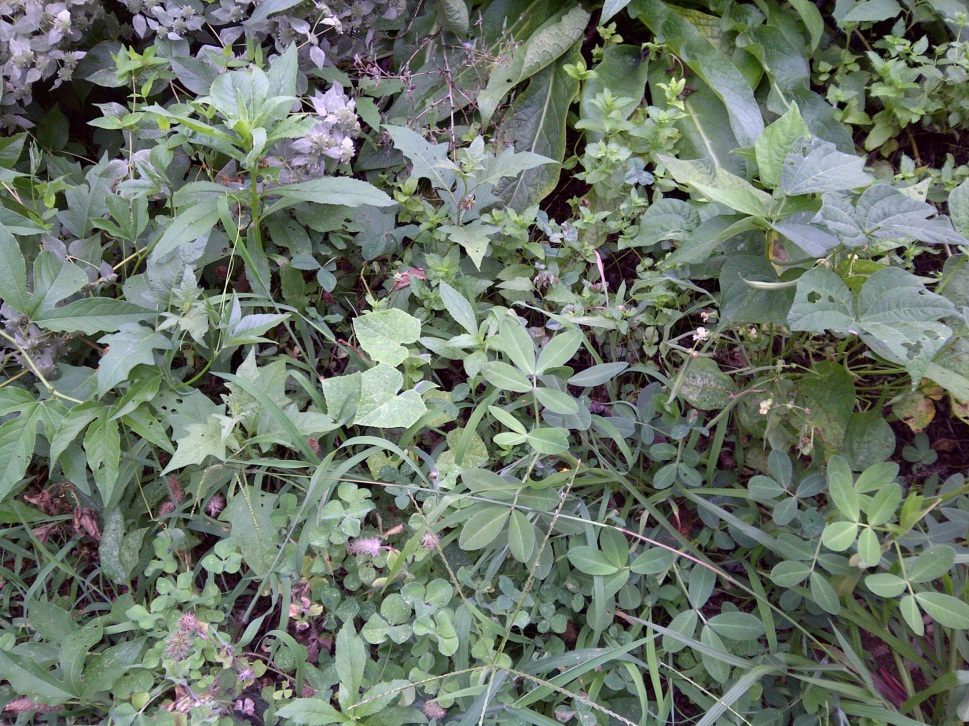
In this close up photo of our Secret Garden of Survival, there are bush beans, cucumbers, peanuts, passion fruit, comfrey, mint, mountain mint, clover and oats- all growing in the same space…And all of this is underneath a pear tree that stands next to blueberry bushes. (Can you find them all?)
-It’s not using pesticide – You need to understand this simple fact: 90% of all bugs are “good bugs”. Good bugs are beneficial insects that in one way or another are essential to the growth and health of your plants. Unfortunately, most insecticides do not discriminate, so they not only kill the bad bugs that you want to eliminate, but they also kill the beneficial insects as well. By killing the good bugs, you interrupt the lifecycle of the predator bugs, and then you leave your plants vulnerable to numerous other pests, that you didn’t even know could be a problem.
Furthermore, once you have killed the predator bugs that were protecting your plants, the “bad bugs” can invade at will, and then your garden suddenly becomes a smorgasbord without anyone there to protect it.
Additionally, these pesticides end up in the soil and they can kill the good microorganisms that allow your plants to be able to take up nutrients.
Nature has its own way of keeping things in balance. When you interfere with nature’s balance by using chemical pesticides, you end up creating an even bigger problem for yourself and your plants – and- you could end up with no crops at all…
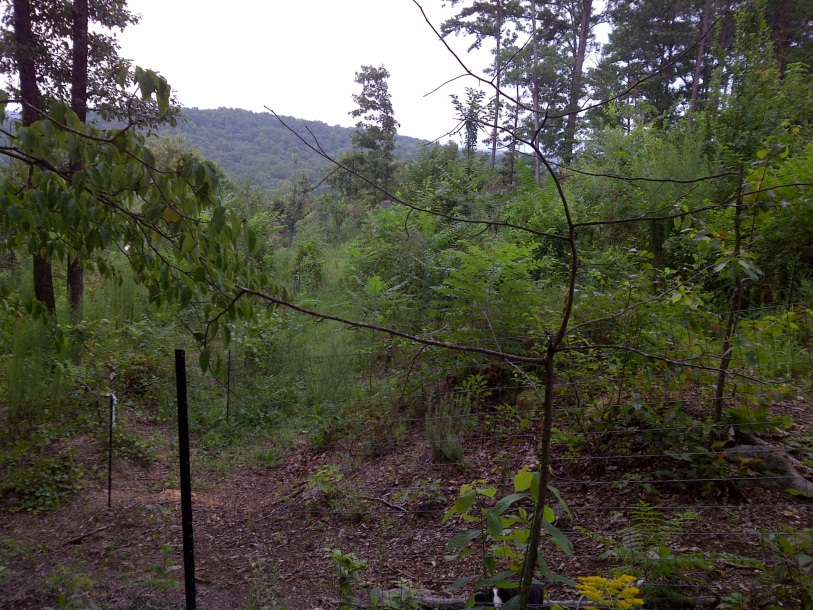
This type of garden looks wild and over grown, because it all blends in.
Even worse, some of these pesticides are systemic. In other words, once they end up in the soil they can then be absorbed throughout the entire system of your plant. So your plants will then carry these pesticides through their roots, into their stems, into their leaves, and into their pollen, thus killing even more good bugs. And if you can ever get fruit to grow under these conditions, these pesticides will now be inside of the food you are going to eat.
Lastly – where do you think you are going to get pesticide when the grid goes down anyway? When there are no stores, and no transportation, there will be no commercial pesticide available. It is far better to never start using them.
-It’s not using fertilizer – In nature, plants grow just fine without commercial fertilizer. Yet almost all commercial farming, and most residential gardens, rely on it. The problem is that using commercial fertilizer is a lot like giving your plants addictive drugs…and once they are addicted, they have a hard time living without it.
And just like pesticide above, where are you going to get commercial fertilizer after TEOTWAWKI (The End Of The World As We Know It)?
…By the way, since the day we started our Secret Garden of Survival, we have never used one single ounce of pesticide or one single once of fertilizer on our plants, and we have always had more food than we could possibly consume.
-It’s not watering- Once your plants are established, there is little to no need for watering in the Secret Garden of Survival. That is because the best place to store water for your garden is in the ground.
In permaculture, we use swales (berms and terraces) to store water. (See the illustration below.) When water drains down into the terrace, it is stopped from flowing further down-hill by the berm on the terrace. The water then seeps into the ground. A lens shaped pool of water forms under the berm. This water is available to the roots of the plants on the berm.
During droughts, when everyone else’s plants were dying, our plants where healthy and green. (For more info see Chapter 4 on Swales, Irrigation, and Micro Climates.)
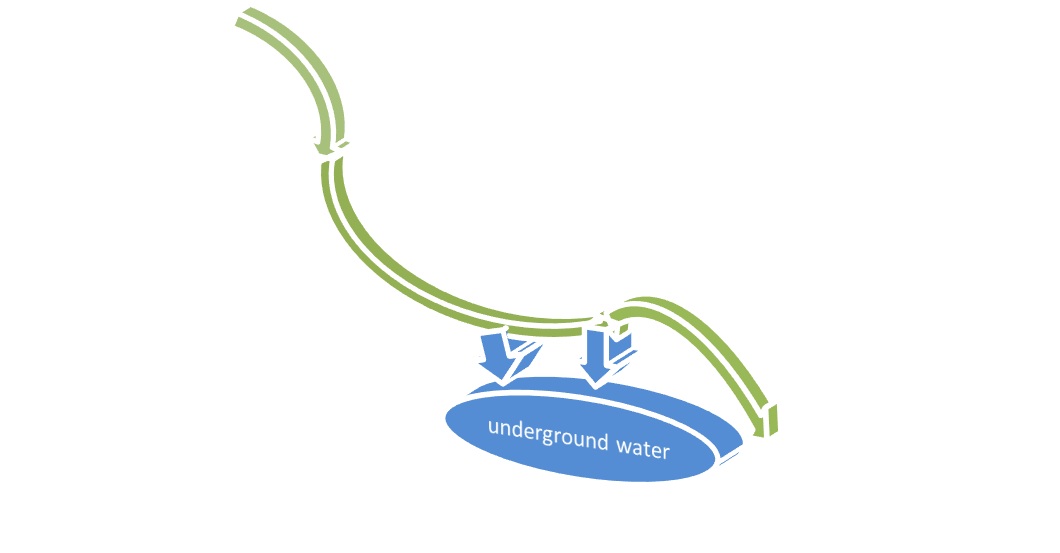
Swales slow downhill water flow creating an underground pool for your plants.
So to sum up, The Secret Garden of Survival is a garden that takes up very little space, that you only have to plant once in your life-time, that will provide food for you and your family for the next 30 years; that can grow five times more food per square foot than traditional or commercial gardening; and it’s a garden that you never have to weed, never have to use fertilizers and never have to use pesticide– ever.
Here is an example of how well it works. It amazes even me. In 2 years- we went from red clay to 12 ft. high blackberries, 15 ft. fruit trees that were bearing fruit, and a lush green food forest that passers-by could not recognize as a “garden”.
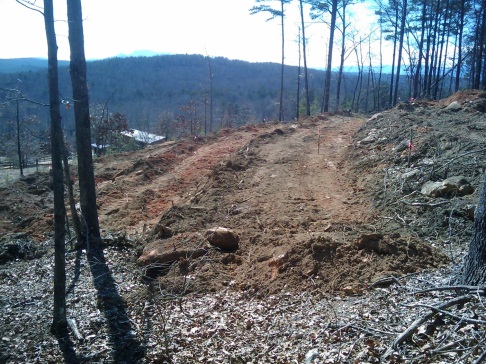
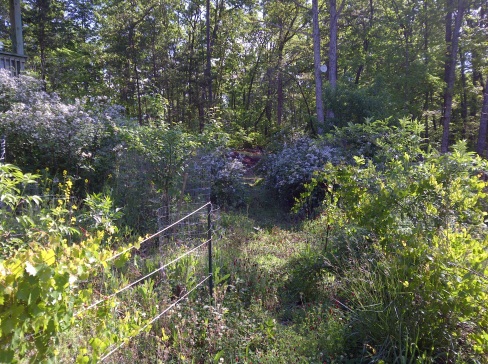
We went from red clay terraces to 12’ high blackberries in just 2 years.
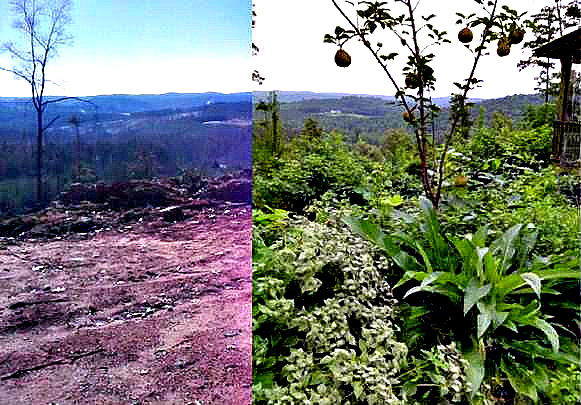
We went from red clay to a lush food forest in just two years.
Now that you know the basics of what it is, and why it works, want to find out HOW YOU can do this?
Then get the book and find out -step by step- how to do it for your property!
Buy the Kindle version:
If you are using an ad blocker and cannot see the images above, please click here to buy the book on Amazon.
Buy the Nook version: click here.
The Secret Garden of Survival(TM) and The Survivalist Gardener(TM), and the Survivalist Gardener avatar all are trademarks of Rick Austin.
This website and all it’s contents are Copyright (C) 2012-2023, Rick Austin, All Rights Reserved.
“Aftermath of Hurricane Sandy” photo, and “Zombie Horde” photo are copyrights of the Associated Press

